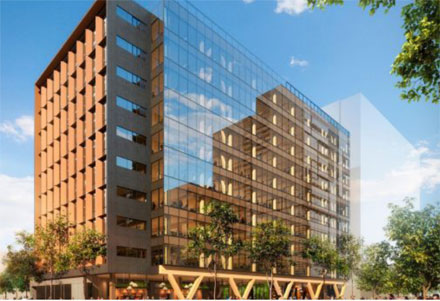
The Australian Building Codes Board (ABCB) released the preview version of the 2019 National Construction Code (NCC) that increases the range of buildings, up to an effective height of 25m, in which fire-protected timber construction systems can be used. The new Classes add schools, retail premises, hospitals and aged care facilities to the previously approved multi-residential, hospitality accommodation and office buildings. Source: Timberbiz
This change is based on extensive work and a successful submission by Forest and Wood Products Australia (FWPA), which extends a Deemed-to-Satisfy solution that was secured in the 2016 NCC permitting, for the first time, construction in fire-protected timber building systems to an effective height of 25 metres (typically 8-storeys) for Class 2, 3 and 5 buildings.
The 2016 change, along with advice from the WoodSolutions Mid-rise Advisory Team, an industry-supported pilot program operated by FWPA in Melbourne and Brisbane, has led to a growing number of mid-rise residential projects considering and adopting timber as the primary building material.
“It’s been incredibly satisfying to see the market acceptance of timber in these projects and this is just the tip of the iceberg,” Ric Sinclair, FWPA’s managing director said.
“Every week we hear from new designers and developers who are realising the cost and speed benefits of timber systems and are looking for more information.
“The timber used in every one of these new mid-rise projects displaces other materials, so it’s effectively creating new market opportunities for timber building system suppliers and added sales volume for our industry.”
Timber building systems include traditional stick or lightweight timber framing and the newer mass timber options, including cross laminated timber (CLT), laminated veneer lumber (LVL) and glue laminated timber (glulam).
“One of the major benefits of the change is that timber will now be an option for mixed use mid-rise buildings, the retail, office and apartment complexes that are growing in popularity in inner and middle suburbs as part of urban infill policies,” Mr Sinclair said.
“Developing and submitting proposals for change to the NCC is part of FWPA’s overall strategy of increasing the volume of wood products by simplifying the process of specification by designers.
“Across our five programs we are actively exploring opportunities to drive the use of wood and increase the social license of the industry as a whole.”
Mr Sinclair would like to thank Boris Iskra, FWPA’s National Codes and Standards Manager, and everyone else involved in preparing the evidence-based Proposal for Change submission.
“It’s a substantial piece of work that is critically assessed by the ABCB’s team of experts and public review, so the success we have had in having our proposals accepted reflect well on the professionalism of our people and industry,” he said.





